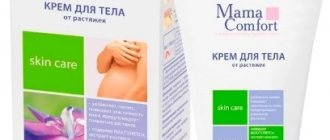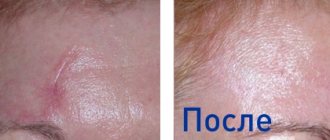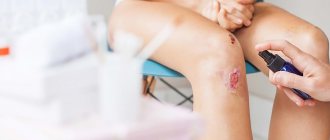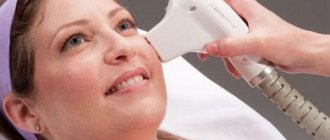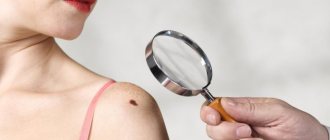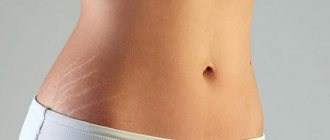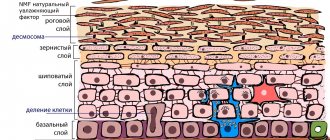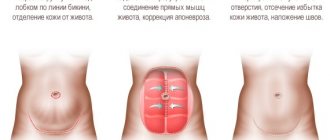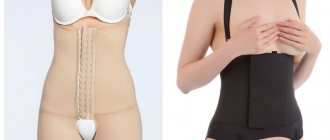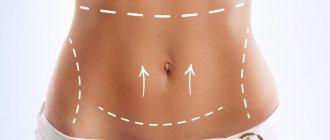Stretch marks, or striae, are strips of connective tissue that appear in areas of skin tension. They do not occur in all people - their appearance depends on the state of health, skin tone, and the stability or instability of weight. Stretch marks are harmless to the body. But they can cause complexes and unnecessary worries. Especially if the stretch marks are located in a visible place - for example, on the shoulders or hips. Having stretch marks can have a detrimental effect on your intimate life. Men and women begin to feel embarrassed about their body if stretch marks are noticeable.
To prevent the appearance of stretch marks, there are many body care products and dietary supplements on the market. If it was not possible to prevent the problem from occurring, you can get rid of stretch marks in different ways. This:
- chemical peels;
- vacuum ultrasonic massage;
- injection mesotherapy;
- RF lifting;
- laser removal;
- surgical excision.
Hardware techniques and peelings are good for fresh stretch marks. They make them less noticeable, but, as a rule, do not remove them completely. Mesococktail injections improve skin quality, but also do not eliminate scar tissue. The disadvantage of surgical removal is the need to polish off the scars remaining after removal with a laser, which delays the process of achieving ideal skin. The surgical method is good when performing operations: for example, during abdominoplasty - tummy tuck - the area with stretch marks can simply be removed.
The most optimal way to get rid of stretch marks is laser exposure. It specifically destroys the connective tissue that forms stretch marks. This leads to the formation of new healthy cells.
Laser resurfacing of stretch marks at the Medial clinic
(Moscow) is a very popular procedure. We use Palomar laser (USA), more about which you can find out here.
What are stretch marks and how do they occur?
Stretch marks, or stretch marks, are microscopic tears in the skin and subcutaneous tissue. They look like stripes and differ from healthy skin in color and structure.
Along with the rupture of the skin, small vessels are injured. Gradually, connective tissue grows in this area. Most often, stretch marks form in people with dry skin and a small amount of collagen and elastin.
The causes of stretch marks can be:
- pregnancy and breastfeeding;
- hormonal changes (in adolescents, during menopause), endocrine diseases;
- sudden change in body weight;
- use of anabolic steroids;
- hormonal therapy.
Stretch marks can occur under the influence of genetic factors. Low amounts of collagen and elastin in the body are inherited.
How does the procedure work?
- Consultation with a cosmetologist to identify contraindications and draw up an individual plan for clinic visits.
- Cleansing and treating the skin with an anesthetic composition.
- Setting the power of the equipment.
- Start of the procedure. The doctor fires a test flash to make sure the laser is set correctly. If everything is in order, the doctor continues to treat the surface of the stretch marks centimeter by centimeter. The laser pulses are painless; a slight tingling and burning sensation may be felt. The duration of the session is from 10 minutes to an hour, depending on the amount of work. Under the influence of the beam, the stretch marks are destroyed, and healthy cells appear in the place of the removed cells.
- Treatment with an anti-inflammatory drug.
- Receiving a recommendation from a cosmetologist.
The next visit to the clinic is usually scheduled 1 month after the first procedure.
Contraindications and possible complications
In these cases, laser treatment of stretch marks is not carried out:
- pregnancy, lactation;
- diabetes;
- epilepsy;
- tendency to form keloid scars;
- problems with blood clotting;
- oncology;
- infections and viruses;
- increased body temperature;
- violation of the integrity of the skin;
- skin diseases.
If the procedure was carried out in violation of the protocol, if the doctor did not take into account the presence of contraindications, and you did not follow the recommendations during the recovery period, the following may occur:
- burns;
- inflammation;
- scars;
- pigmentation.
Please note that redness, swelling, and moderate pain after the procedure are normal and will go away in a couple of days.
Recommendations for the recovery period:
- use healing ointments and antibiotics (if necessary);
- do not go to the pool, sauna, beach, or solarium for two weeks;
- do not steam your skin at home;
- Do not touch or rub areas treated with laser.
As a result:
- the skin will acquire an even color, its tone will increase;
- Striae will become less noticeable after the first procedure.
Two or more removal sessions will be required to achieve optimal results.
Types of stretch marks
Striae on the body differ in structure and time of formation. Externally, the difference can be seen in color. There are several types:
- Pink ones are the freshest. Scar tissue has just formed and is located close to the surface.
- Violet is the next stage of development. At this time, you can still solve the problem with cosmetics.
- Blue - indicate the “age” of striae 4-5 months.
- White – micro-tears in the skin occurred more than 8 months ago.
Old scars can only be removed using laser or surgical methods.
I. Scars
Any visible mark left after a wound has healed is considered a scar.
Often the scars are minor and go away on their own after some time. Serious damage to the skin can lead to scarring. The main causes of scars are diseases, surgical interventions, and injuries. Scarring is a natural part of the skin's healing process. The appearance of the scar, as well as the treatment method, depend on many factors. The depth, area of the wound, its location on the body, age, gender of the person, genetic predisposition and ethnicity are important.
Laser stretch mark removal methods
Laser stretch mark removal is the best way to solve the problem. It allows you to get rid of old stripes that do not respond to conservative methods. Compared to surgery, laser removal is safe, less traumatic and does not require long-term rehabilitation. The price of laser stretch mark removal is lower compared to surgery.
For stretch marks of different “ages” and structures, different types of polishing are used.
Stretch marks: no longer forever
Home › Blog › Stretch marks: no longer forever
90% of women with children face the problem of stretch marks. To say that they cause women aesthetic discomfort is an understatement.
Often this problem aggravates and even provokes so-called postpartum depression, when a woman cannot accept the new reality and new physical form. Traditionally, it is believed that it is impossible to get rid of stretch marks.
Few women know about new laser technology that solves this problem effectively and safely. LINLINE client Maria Shaposhnikova told her story of struggling with stretch marks, which, fortunately, ended well.
Maria Shaposhnikova: In June 2014, I gave birth to a child, and because of this, I had a problem with stretch marks on my stomach. Stretch marks appeared at 41 weeks of pregnancy. If I had given birth at 40 weeks, they would not have been there.
But the most interesting thing is that they appeared literally before my eyes! Suddenly my stomach began to itch terribly. And half an hour later I discovered stretch marks on my stomach! In the first month after giving birth, I used scar ointment every day, as written in the instructions. The situation did not improve, and in addition, I became allergic to this drug, and I stopped the experiment.
I had seen stretch marks on people I knew before, I knew what they looked like over time or after tanning. They do not go away on their own, but become even more noticeable. And there is nothing pleasant about it. I chose LINLINE because I had previously undergone laser hair removal and tumor removal at the clinic, and was satisfied with the result.
Four months after giving birth, I came for a consultation. I was told about the RecoSMA procedure, which removes stretch marks. But the doctor said that laser is contraindicated during breastfeeding, and recommended that I come when I am ready to finish feeding. And I came almost a year after giving birth.
The procedure was not painful at all, I tolerated it absolutely comfortably. After each procedure, the stomach peels for almost a month. The peeling didn't cause me any discomfort either. The first time I hardly noticed the effect. But after the second procedure, it was very noticeable that the stretch marks became less bright and the skin structure smoothed out!
I did four procedures in total, and now I am very pleased with the result.
Lyubov Eskova, dermatocosmetologist, laser therapist at the LINLINE clinic: Two factors are important for successful laser treatment of stretch marks.
First: you need to contact a specialist as early as possible. If stretch marks appeared during pregnancy, then you need to start treatment immediately after breastfeeding. Of course, at LINLINE we also successfully treat “old” stretch marks, but the results in this case will appear later.
The second factor is compliance with the frequency of treatment. Too long breaks between treatments can slow down the effect. It should be remembered that the procedure for laser removal of stretch marks can be done no more than once a month. Maria followed both rules, and her stretch mark treatment was very successful. Already, the stretch marks are practically invisible, but Maria wants to achieve an ideal result and is going to come for another procedure.
As a rule, after 6-7 procedures the effect reaches its maximum. The secret of laser stretch mark removal is that under the influence of a laser beam, the cells of the damaged skin area are restored, forming new collagen and elastin fibers. The skin is reconstructed and takes on its previous appearance - what it was before the damage.
The effectiveness of RecoSMA has been proven in numerous clinical studies in Russia and abroad. Tens of thousands of similar procedures have been carried out, and you can be confident in their safety. The procedure does not require any special preparation or pain relief and is very comfortable and painless.
The laser light is divided into many microbeams that do not damage the skin, so all you feel is a hot tingling sensation. Significant changes become fully noticeable within two to three months after RecoSMA, because the procedure gives cells an incentive to renew. Every day you notice that the skin becomes more even, smooth, the boundaries between scars and normal skin are blurred.
How long does a full stretch mark removal course take?
The number of procedures is determined by the doctor individually for each patient during consultation.
How is RecoSMA different from chemical peeling?
Chemical peeling acts only at the level of the epidermis and cannot affect scar tissue in any way. And the laser acts up to 6 mm in depth, reconstructing the skin to the state that was genetically determined: without scars or damage.
Are there any restrictions after laser treatment for stretch marks?
There are no restrictions. You can lead your usual lifestyle, wear any clothes, go to the pool and the beach.
Is it possible to remove stretch marks on the chest?
RecoSMA is the only technique recommended for the removal of stretch marks on any areas of the body that are prone to their appearance: abdomen, thighs, buttocks, breasts.
Are there any contraindications for laser stretch mark removal?
There are no special contraindications, but it is better not to carry out the procedure during pregnancy and breastfeeding, during infectious diseases and at elevated temperatures.
Prices
| RekoSMA | ||
| RekoSMA 1 local area | from 6360 ₽ | Sign up |
| RecoSMA zones up to 200 cm2 (hands/elbows/knees/décolleté/chin) | from 11200 ₽ | Sign up |
| RekoSMA faces | from 24450 ₽ | Sign up |
Reviews Elena Sidelnik (Lipetsk) writes:
It was my first time at the clinic! This was my first time doing a laser procedure on my entire face. I was satisfied with the procedure, although the sensations were not comfortable. Thank you Nastya for a professional job done. We will see the result!!))
Write your review | View other reviews
go to blog
Popular posts
2015/02/24
RecoSMA: Dreams come true!
2016/01/21
Childhood without complexes. How to prevent scars from ruining a child’s life?
2017/12/04
Breast rejuvenation and lift
2016/05/20
Stretch marks: no longer forever
2016/08/16
All about the treatment of hyperhidrosis
Deep grinding
The method involves complete removal of the epidermis and partial removal of the dermis. The laser beam evaporates skin cells, injuring it in the process. In response, the body launches regeneration processes. Collagen synthesis is activated, epidermal cells are renewed.
It is better to carry out the procedure with a carbon dioxide laser. This type provides the deepest sanding. After evaporation of the surface layers of tissue, the deeper cells and vessels are “sealed.” This way there are no open bleeding wounds left on the skin. There is no need to apply a bandage to the treated surface. Healing occurs faster than with other lasers.
Progress of laser resurfacing
After an in-person consultation and examination, the doctor determines the type of laser, its power and procedures for maximum effectiveness.
The area of the planned laser treatment is treated with an antiseptic solution and an application cream is applied, with which the patient should remain for 20 to 50 minutes, depending on the selected power and procedure regulations.
After the application anesthesia has taken full effect, the doctor begins the procedure. During grinding, for additional comfort, cold air is applied to the treatment area.
The duration of the procedure directly depends on the laser treatment mode and the area of the treatment area. The abdominal area can be treated partially or completely. On average, the duration of resurfacing the abdominal area takes 30-45 minutes, excluding the patient’s stay under anesthesia.
Combined abdominal resurfacing with deep stretching
Laser Thor Co2 abdomen resurfacing in progress
Ablative resurfacing
Method of layer-by-layer exposure to the surface layers of the epidermis. As a result of the treatment, natural collagen synthesis is launched. The type of laser depends on the depth of the lesion.
For superficial stretch marks, erbium devices can be used. Deep, old stretch marks are best removed with a carbon dioxide laser.
The advantage of the method is the absence of scars on the skin and reduction of its area to the desired state. The disadvantage is an aggressive effect on the skin and the possibility of infection.
The recovery period after treatment takes from 20 days to 2 months. At this time, it is important to follow all doctor's recommendations.
What other approaches to treating stretch marks exist?
Before the advent of lasers, various types of medium and deep peels were used to treat stretch marks. However, a long rehabilitation period and a high risk of infection limit the range of application of this method. Today, superficial-medium peelings are used to correct small stretch marks. Coral peeling is the most effective.
How to get rid of stretch marks without resorting to laser? There are various methods, it all depends on the severity of the problem. Along with radical treatment of stretch marks using laser resurfacing, preventive methods should not be excluded to prevent the spread and formation of new stretch marks: the use of tightening and firming creams at home, various body wraps, body mesotherapy, biorevitalization. These procedures accelerate the restoration and healing of the skin after laser resurfacing, nourish and moisturize the skin.
To treat sagging skin, which is often combined with stretch marks that occur after childbirth, a thermolifting body procedure is recommended. The result is due to the stimulation of collagen synthesis in the area between the stretch marks, which leads to a narrowing of the stretch marks in width and thickening of the skin.
If you are tormented by the question: how to get rid of stretch marks and this unpleasant cosmetic defect has become your constant companion, make an appointment with a dermatocosmetologist.
Non-ablative resurfacing
This technique is considered gentle and low-traumatic. The laser beam immediately penetrates into the deep layers of the dermis. The surface layers of cells are not damaged. A beam of light waves destroys fibroblasts (cells responsible for the production of connective tissue). Partial denaturation of the protein occurs. With this effect, the texture of the skin improves and its natural color returns.
The main advantage of non-ablative resurfacing is minimal trauma to the skin. The recovery period takes no more than 2-3 days. The method is suitable for all skin types, including dark skin.
Main types of scars
- Keloids . These scars are the result of an overly aggressive healing process caused by the production of large amounts of collagen. Often itchy or painful, these scars tend to grow and become even larger than the original wound.
- Contracture . These are the scars that remain on the body after burns and seem to tighten the skin. These scars can spread deeper into the muscle tissue.
- Hypertrophied . These are pinkish scars that look similar to keloids, but do not extend beyond the boundaries of the original wound. Over time, such scars may resolve.
- Atrophic . Such scars are usually a sign of post-acne; they can remain after the removal of a mole or after chicken pox. They are characterized by the fact that the scar itself is below the level of the skin, which is not able to regenerate tissue.
All these types of scars, except keloid, can be removed or significantly reduced using the Scanning more-Xel . The principle of operation of the device is the same as for the laser resurfacing procedure. The laser beam acts on the upper layers of the skin, “evaporating” them along with scars and irregularities. The skin becomes smooth and elastic.
Keloid scars can only be removed by surgical methods and injections of hormonal drugs.
Unfortunately, there is currently no 100% effective way to remove all types of scars. Large scars usually cannot be completely removed; they can only be reduced, making them almost invisible.
Factional
This laser resurfacing of stretch marks involves a targeted effect on the skin (the technology of “penetrating” a beam of light into the connective tissue is used). It is advisable to use a carbon dioxide laser.
Using a special attachment, the light beam is divided into several thin fractions (similar to a shower head). Penetrating into the deep layers of the skin, the laser makes microscopic cone-shaped holes in it. These damages stimulate the synthesis of young fibroblasts, collagen production and renewal of the capillary network.
Fractional resurfacing is used to remove stretch marks from particularly sensitive areas - breasts, inner thighs.
The maximum effect can be obtained by combining fractional and continuous laser effects on the skin.
FAQ
Is it possible to completely remove stretch marks with a laser?
Currently, among minimally invasive methods, only laser can remove stretch marks completely, without any traces.
How many treatments are required to completely remove stretch marks?
The number of procedures depends on the characteristics of the skin of a particular patient or patient, the size and “age” of stretch marks. A cosmetologist will be able to give an approximate amount after a personal examination. On average, 2-4 sessions are enough.
It hurts?
No, it doesn’t hurt at all, since the procedure is performed using topical anesthesia. In particularly advanced cases, local injection anesthesia is possible.
What is the interval between procedures?
The interval is 1-1.5 months. Yes, you will have to be a little patient, but the result is worth it.
Will stretch marks appear again?
Lifestyle plays a big role here. If you exclude skin stretching due to weight gain and pregnancy, and take care of your skin with cosmetics, clear, smooth skin will remain for many years
Reasons for the formation of stretch marks on the skin
Among the main reasons that result in the formation of stretch marks, it should be noted:
- Hormonal imbalance. Striae on the skin can appear in adolescence during puberty, as well as in girls and women with ovarian dysfunction, etc. This process on the skin is reversible when body functions are restored.
- Weight fluctuation. When you gain weight, in conditions of excess subcutaneous fat, metabolic processes and blood microcirculation processes are disrupted in the dermis, which slows down the synthesis of the main framework proteins collagen and especially elastin. The skin does not have time to acquire the desired shape and elasticity in time, as a result of which micro-tears form and stretch marks form.
- Pregnancy. The rapid growth of the fetus in late pregnancy, enlargement of the mammary glands during this period, and sometimes inadequate weight gain provoke the formation of stretch marks - in slang “stretch marks after childbirth.”
- When building up a large amount of muscle tissue in athletes.
- Endocrine and other diseases. Stretch marks can be the result of a serious illness - Cushing's disease or syndrome, pituitary-hypothalamic dysfunction, etc., or taking various medications and hormonal drugs. In this case, not only elastin synthesis in the dermis suffers, but also the collagen framework protein actively degrades.
II. Stretch marks (striae)
On average, about 70-80% of women who give birth suffer from stretch marks. Striae are also common in teenage girls as they go through rapid growth stages, as well as in men and women who gain weight quickly.
Stretch marks form in the dermis (the middle layer of the skin) when the connective tissue is stretched to a critical level. As the body grows, the connective fibers in the dermis tend to stretch slowly. However, rapid growth leads to sudden, sharp stretching, resulting in rupture of the dermis, while the upper layer of skin (epidermis) remains intact.
The most common stretch marks are:
- stomach
- breast
- hips
- buttocks
The best option for getting rid of stretch marks is to use a CO2 fractional laser. It is usually used to remove scars and scars, but it also works well on stretch marks. The CO2 laser stimulates collagen production at the site of the procedure and promotes skin tightening. This, in turn, causes the stretch marks to decrease.
